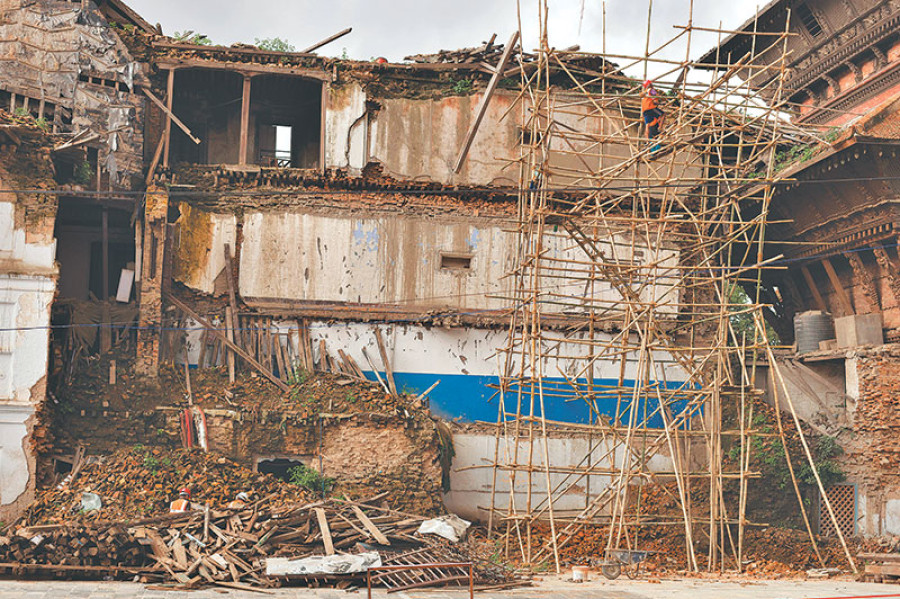Valley
Tardy rebuilding efforts put monuments in peril
Several cultural heritage sites in Kathmandu Valley continue to remain in rubbles more than two years after they were destroyed by the Gorkha Earthquake.
Samipa Khanal
Several cultural heritage sites in Kathmandu Valley continue to remain in rubbles more than two years after they were destroyed by the Gorkha Earthquake. Stakeholders blame a host of reasons, including red tape, short supply of skilled human resources and construction materials, non-cooperation from locals and lack of political will for the delays.
An official estimate suggests that more than 85 percent of historically and culturally important heritage sites in Kathmandu, Bhaktapur and Lalitpur were either destroyed or damaged to varying degrees by the earthquake that hit the central Nepal on April 25, 2015.
Data obtained by the Post shows reconstruction works have yet to start in more than 70 percent of heritage sites in the Valley, while works do not look satisfactory even in sites undergoing reconstructions.
Bhaktapur, one of the worst-hit districts in term of damages inflicted upon by the disaster, has seen the least amount of reconstruction works at heritage sites. Many iconic monuments from Malla dynasty, including the Fasi Deva temple, the Chardham temple and the 17th century Vatsala Durga temple were damaged in the earthquake.
Out of 114 historical and cultural monuments destroyed by the quake in Bhaktapur, only five monuments located at Bhaktapur Durbar Square have been rebuilt while the reconstruction and restoration works have started only at 14 other sites.
Kathmandu, the heart of the country renowned worldwide for its cultural heritage, is facing similar apathy from the government. Only 22 historical monuments of lesser importance have so far been renovated out of 239 fully, partially and partly damaged monuments, with the reconstruction process on the run at 33 other sites.
However, some of the important sites, including Basantapur Durbar, Panchtale temple, nine-storey Basantapur Durbar, Dasa Avtar temple, Krishna temple and two other temples located behind the Shiva Parvati temple still await reconstruction.
The authorities, however, maintain that the reconstruction works should be carried out only after a thorough planning. “Construction of cultural heritages is not like building houses. The foundation has to be strong,” said Ram Bahadur Kunwar, spokesperson for the Department of Archaeology (DoA). “We have to arrange construction materials, we lack trained artisans adding “Preliminary works such as documentation, planning, drawing, arrangements of the materials takes time.”
Reconstruction of Kasthamandap—an early 7th century wooden monument from which Kathmandu got its name—is also in limbo due to disputes between the locals and the Kathmandu Metropolitan City Office. The KMC has taken the responsibility to build the monument.
The Bouddhanath Stupa at Bouddha was the first heritage site to be rebuilt, thanks to the efforts of the Bouddhanath Area Development Committee (BADC). Various monuments are under construction but only a few have been restored to their former glory.
Reconstruction works have taken place in 17 monuments out of 223 damaged monuments in Lalitpur that boasts hundreds of historically important cultural sites. The earthquake had partially damaged several monumentss, including Char Narayan Mandir and Yog Narendra Malla’s statue.
“We would have picked up the pace if the government had cooperated us with the budget,” said Archaeology Officer at DoA Sabita Neupane. She recalls asking the National Reconstruction Authority (NRA) for a grant to train the craftsmen but says the amount was transferred only after a year. This year the government has allocated Rs 509 million for the construction of the quake-damaged cultural monuments. Out of that 75 percent has already been utilised, according to the DoA.
“We have to admit that the construction process had been slow for two years but the works have been accelerated off late,” said Neupane.
“We have already called tenders for multi-year construction of the heritages and we are committed to complete them in time.”




 8.12°C Kathmandu
8.12°C Kathmandu









%20(1).jpg&w=300&height=200)

